Introduction
The Phantom 3 4K by DJI stands as a significant milestone in consumer drone technology, blending robust aerial imaging with intelligent flight features optimized for both enthusiasts and professional users. Designed to capture ultra-high-definition aerial footage, it integrates a sophisticated camera system, advanced wireless communications, and a suite of safety and automation tools.
At the heart of its regulatory compliance is its FCC certification under FCC ID SS3-GL3581511. While a grant date is not specified, this certification ensures the Phantom 3 4K adheres to stringent US radio frequency (RF) emission standards, making it legal for sale and operation within the United States. This article delivers a comprehensive breakdown of the Phantom 3 4K, from its standout technical specifications and wireless technologies to an expert-level teardown analysis of its internal components. We’ll also demystify its FCC documentation and explore the practical impact of its regulatory status.
Key Features & Specifications
The DJI Phantom 3 4K is engineered for reliability, ease of use, and high-fidelity aerial imaging. Its capabilities are a blend of thoughtful hardware design and intelligent software integration. Below, we detail the features and technical specs that define this drone’s performance:
Key Features
-
Return-to-Home (RTH) Button
Instantly commands the drone to return to its takeoff point, enhancing flight safety and user confidence—ideal for beginners and professionals alike. -
3-Axis Gimbal with 120˚ Tilt Range
Provides rock-steady stabilization for both photos and videos, minimizing motion blur and maintaining horizon-level footage, even during dynamic maneuvers. -
Integrated 2.4 GHz WiFi Video Downlink
Enables real-time HD video transmission to a mobile device up to 0.62 miles (1,000 meters), supporting on-the-fly framing and live monitoring. -
Anti-Drop Kit for Gimbal and Camera
Adds a physical safeguard, reducing the risk of accidental camera detachment during flight or rough landings. -
Multiple Video Formats
Supports both MOV and MP4 formats, enabling flexible editing workflows and broad compatibility with popular media platforms. -
DJI GO App Integration
- Map: Real-time flight path visualization.
- Academy: In-app learning resources.
- User Center: Flight log management.
- Director: Automatic video editing for instant highlight reels.
-
Discovery: Sync media, access flight logs, and share content.
-
Customizable C1 and C2 Buttons (Remote Controller)
Assign frequently used functions for rapid access, tailoring the flying experience to individual preferences.
Technical Specifications
- Camera:
- Sensor: 1/2.3 inch CMOS
- Stills: 12 megapixels
- Video: Up to 4096×2160p at 24fps, or 4K at up to 30fps
-
Supported Formats: MOV, MP4
-
Remote Controller:
- Battery: 2S rechargeable, 6000 mAh
- Effective Communication Range: Up to 0.62 miles (1,000 meters)
-
Buttons: RTH, customizable C1/C2
-
Wireless Connectivity:
- Wi-Fi: Integrated 2.4 GHz for video downlink and control
-
Bluetooth: Present (specific details not available)
-
Flight & Environmental:
- Operating Altitude: Caution above 6,000 meters (19,685 ft) due to reduced battery/aircraft performance
- Recommended Wind Speed: Below 10 m/s for optimal stability
-
Operating Temperature: Performance may vary with temperature and altitude
-
Other:
- Anti-drop kit included
- DJI GO app compatibility (iOS/Android)
This combination of robust hardware and intuitive software makes the Phantom 3 4K a versatile tool for aerial videography, mapping, and recreational flying, catering to a wide spectrum of users.
Operating Frequencies
The Phantom 3 4K, as documented in its FCC filing (FCC ID SS3-GL3581511), operates on the following frequency range and power level:
| Frequency Range (GHz) | Output Power (mW) | FCC Rule Part |
|---|---|---|
| 2.412 – 2.462 | 401 | 15CMO1.15.738 |
These frequencies correspond to the 2.4 GHz ISM band, which is widely used for Wi-Fi, remote control, and low-latency video transmission. The specified output power of 401 mW supports robust wireless communication, contributing to the drone’s effective control and live video range.
Technology Deep Dive
The Phantom 3 4K leverages a combination of 2.4 GHz Wi-Fi and Bluetooth technologies to enable seamless communication between the drone, its remote controller, and the user’s mobile device. The use of the 2.4 GHz band ensures compatibility with standard wireless devices and provides a balance between range, bandwidth, and resistance to interference. Bluetooth, while present, is likely used for device pairing or auxiliary functions, as primary control and video downlink are handled via Wi-Fi.
Operating within the 2.4 GHz ISM band delivers several advantages:
– Performance & Range: The 401 mW output power supports strong signal penetration and a maximum range of up to 1,000 meters, ideal for both open environments and areas with moderate RF congestion.
– Interference Mitigation: While the 2.4 GHz band is shared with many consumer devices, the Phantom 3 4K’s robust RF design—including shielding and filtering—helps maintain reliable links.
– Power Consumption: Efficient RF components and local power regulation minimize battery drain, maximizing flight and controller endurance.
Test reports and user manuals confirm the system’s focus on wireless reliability, with EMI/RFI shielding and modular antenna design further enhancing its operational integrity. The result is a drone platform optimized for stable, long-range video and telemetry—crucial for demanding aerial imaging tasks.
In-Depth Internal Component Analysis / Teardown
Main Interface PCB: Modular Connectivity and Robust Construction
The internal interface board features a black ENIG-finished PCB with a straightforward layout, primarily supporting multiple connectors rather than housing complex logic or RF circuits. Notable elements include a micro-USB port for data transfer or firmware updates, a large FPC connector for camera or gimbal interfacing, and several smaller connectors for power or sensor links. The wide traces and absence of high-speed signal routing highlight its role as a breakout or secondary interface, facilitating modular assembly and easy servicing. The clean silkscreen, well-aligned mounting holes, and minimal passive components indicate a focus on reliability and manufacturability rather than computational complexity.
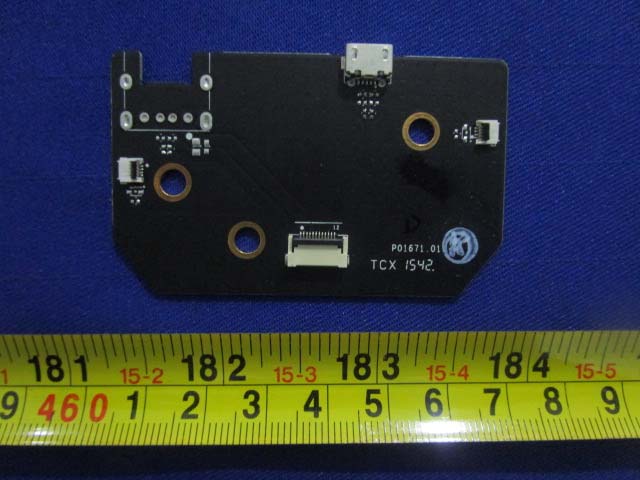
Remote Controller PCB: Advanced RF Engineering and User Interface Integration
The remote controller’s internal PCB exemplifies high-end design, with a densely populated black board segmented into distinct functional areas. A large RF shield protects the main wireless transceiver—likely a Wi-Fi/Bluetooth SoC—ensuring compliance with EMI regulations and reliable long-range operation. External antennas are connected via micro-coaxial cables, maximizing signal clarity. High-capacity local power regulation is evident through large capacitors and inductors, supporting the 6000 mAh battery. Modular joystick assemblies and tactile switches are neatly integrated, while well-routed harnesses and clear labeling facilitate both assembly and field servicing. The overall architecture reflects DJI’s commitment to robust wireless performance and ergonomic user control.
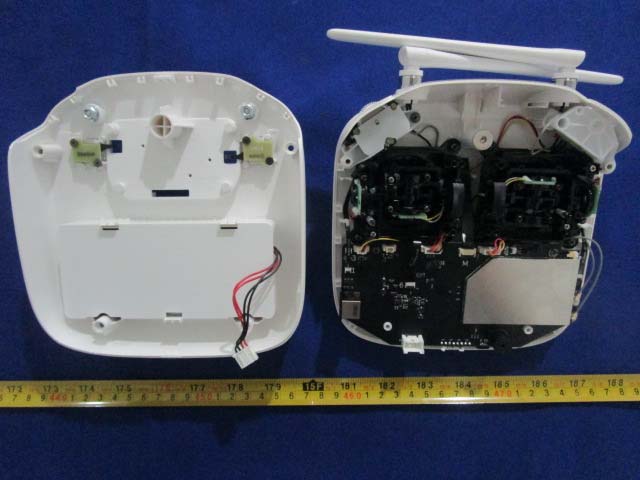
Central Flight Controller PCB: Shielded Processing and System Integration
The central PCB within the drone body is a multi-layer, black FR4 board featuring a substantial EMI shield that likely covers the main SoC and RF transceivers. Multiple FPC connectors line the board’s edge, supporting modular connections to the camera, gimbal, and antennas. Careful grounding, visible through stitching vias, underscores attention to RF integrity and regulatory standards. Local power regulation is present near the power input connector, while a piezo buzzer provides audible status alerts. The organized component layout and robust shielding ensure reliable processing, wireless communication, and system integration—fundamental for stable flight and high-definition video transmission.
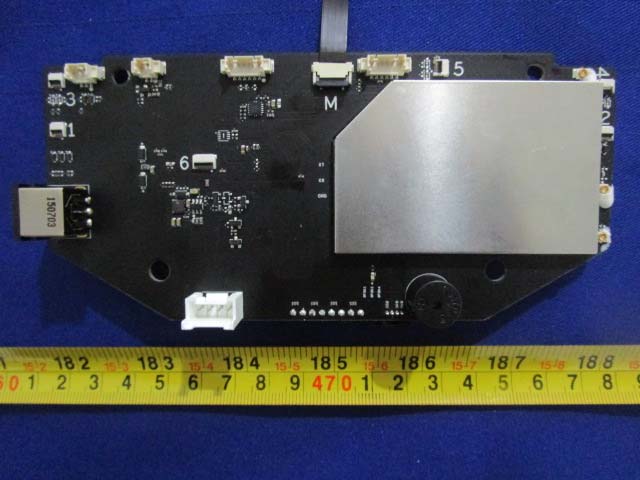
Wireless SoC Subsystem: High-Performance Wi-Fi Integration
A close-up view of the wireless subsystem reveals the Atheros AR9342-BL1A SoC, a powerful 2.4/5 GHz Wi-Fi processor with integrated MIPS CPU. This IC is responsible for handling high-throughput video and telemetry links, critical for the Phantom 3 4K’s real-time HD downlink. The PCB’s dense layout and fine-pitch traces are optimized for RF signal integrity, with a partially visible metal shield ensuring compliance with emission standards and protecting against interference. Surrounding SMD passives provide filtering and decoupling, supporting both the SoC’s performance and system stability. This high-integration approach enables the Phantom 3 4K’s robust long-range wireless capabilities.
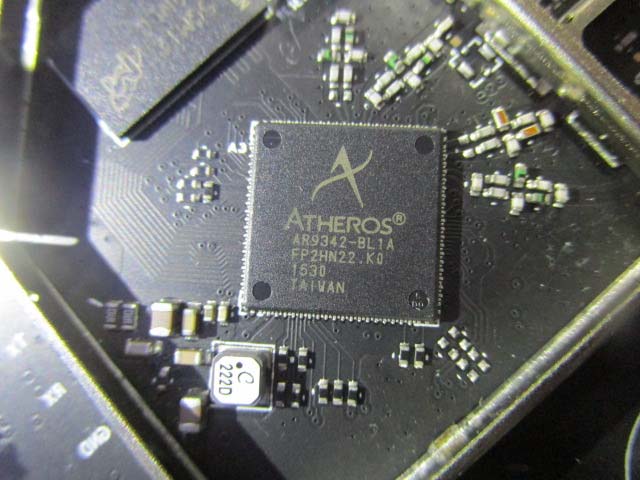
FPGA-Driven Processing Board: Custom Logic for Flight and Video
A prominent Xilinx FPGA or CPLD sits at the heart of this board, indicative of significant onboard processing for real-time flight control, sensor fusion, or video handling. Multiple shielded compartments segregate sensitive RF and analog sections from digital logic, reducing EMI and ensuring regulatory compliance. Robust white connectors enable secure links to motors, sensors, and other peripherals, while large capacitors and inductors provide stable local power. The inclusion of a crystal oscillator ensures precise timing, essential for both flight control and wireless communications. This modular, shielded architecture demonstrates DJI’s advanced engineering and attention to both performance and serviceability.
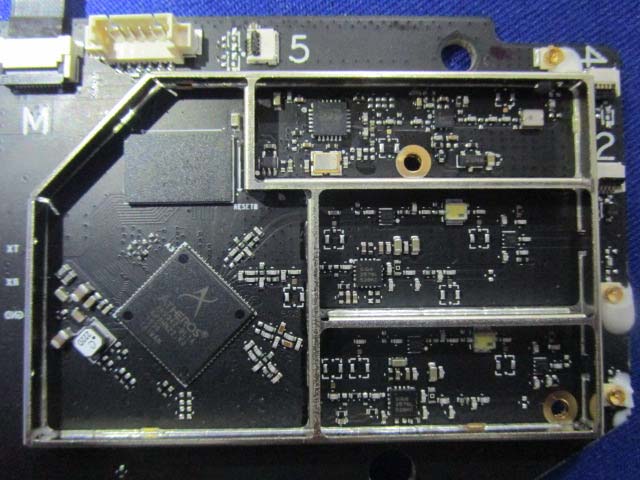
Main Communications & Power Board: Integrated RF and System Control
This PCB integrates several major ICs—likely including the main processor and RF SoC—within a shielded compartment, supporting critical communications and video functions. Multiple FPC and JST connectors facilitate modular integration with antennas, motors, and other subsystems. Localized power regulation is visible via large capacitors and inductors near the connectors, while a piezo buzzer offers audible system alerts. The dense, right-side component layout and the strategic placement of ground pours and stitching vias emphasize EMI control and signal integrity. This board exemplifies DJI’s focus on modularity, robust RF design, and ease of manufacturing—key for maintaining the Phantom 3 4K’s reliability in the field.
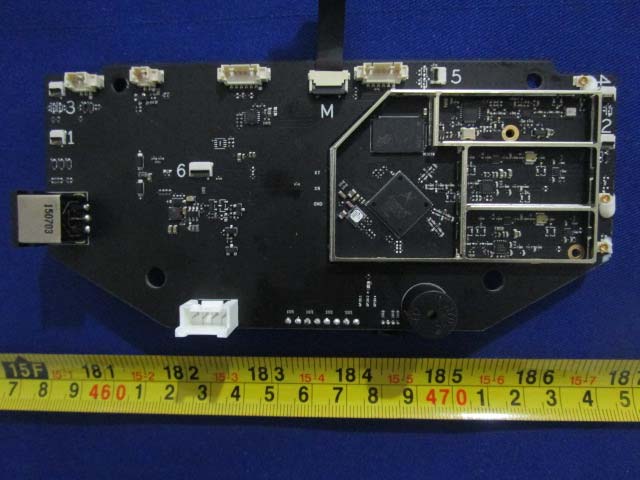
Regulatory Insights & FCC Filing
The Phantom 3 4K’s FCC ID SS3-GL3581511 certification is a testament to its compliance with US regulations governing RF emissions, electromagnetic compatibility, and device safety. This certification is crucial—it confirms the drone is legal for sale and use within the United States, and that it meets strict standards for interference mitigation and safe operation.
The FCC filing for SS3-GL3581511 typically includes:
– Test Reports: Detailed measurements of RF output, spurious emissions, and electromagnetic compatibility (EMC).
– User Manuals: Comprehensive guides to operation, safety, and feature use (as seen in User-Manual-1-2830944.pdf and User-Manual-2-2830945.pdf).
– Internal & External Photos: High-resolution images for verifying device construction and antenna placement.
– Schematics & Block Diagrams: Technical documentation outlining circuit design and signal paths.
Insights from the official user manuals highlight the Phantom 3 4K’s advanced features—such as integrated 4K video capture, a stabilized gimbal, and a Vision Positioning System for precise hovering. The documentation also details the DJI GO app’s role in enabling live HD video previews, automatic video editing, and flight safety features like No-Fly Zone enforcement. This regulatory transparency gives users confidence in the device’s safety, reliability, and technological sophistication.
Potential Use Cases & Target Audience
With its blend of professional-grade imaging, robust wireless performance, and intelligent automation, the Phantom 3 4K is well-suited for several key user scenarios:
-
Aerial Videography & Photography
Content creators, filmmakers, and real estate professionals benefit from stabilized 4K footage, live HD previews on mobile devices, and seamless integration with post-production workflows via MOV/MP4 formats. -
Mapping & Surveying
Surveyors and engineers can leverage precise flight controls, automated return-to-home, and geotagged imagery to efficiently collect data for mapping, construction, or agricultural analysis. -
Recreational & Educational Use
Hobbyists and STEM educators enjoy accessible flight controls, built-in safety features, and interactive learning via the DJI GO app’s Academy and Director modules. The anti-drop kit and return-to-home functions reduce barriers for new pilots, making advanced aerial technology approachable for all experience levels.
Conclusion
The DJI Phantom 3 4K (Model: Phantom 3 4K, FCC ID SS3-GL3581511) stands as a prime example of modern drone engineering—combining advanced wireless technology, modular internal design, and robust regulatory compliance. Its FCC certification not only ensures legal operation but also reflects a commitment to RF integrity and user safety. With professional-grade imaging, intelligent automation, and meticulous hardware construction, the Phantom 3 4K remains a compelling choice for creators, professionals, and enthusiasts seeking reliable aerial performance backed by proven regulatory standards.